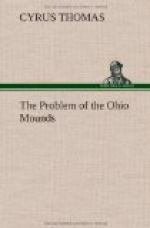There is another link equally strong. In a number of the larger mounds on the sites of the “over-hill towns,” in Blount and Loudon Counties, Tenn., saucer-shaped beds of burnt clay, one above another, alternating with layers of coals and ashes, were found. Similar beds were also found in the mounds at Charleston. These are also unusual, and, so far as I am aware, have been found only in these two localities. Possibly they are outgrowths of the clay altars of the Ohio mounds, and, if so, reveal to us the probable use of these strange structures. They were places where captives were tortured and burned, the most common sacrifices the Indians were accustomed to make. Be this supposition worthy of consideration or not, it is a fact worthy of notice in this connection that in one of the large mounds in this Kanawha group one of the so-called “clay altars” was found at the bottom of precisely the same pattern as those found by Squier and Davis in the mounds of Ohio.
In these mounds were also found wooden vaults, constructed In exactly the same manner as that in the lower part of the Grave Creek mound; also others of the pattern of those found in the Ohio mounds, in which bark wrappings were used to enshroud the dead. Hammered copper bracelets, hematite celts and hemispheres, and mica plates, so characteristic of the Ohio tumuli, were also discovered here; and, as in East Tennessee and Ohio, we find at the bottom of mounds in this locality the post-holes or little pits which have recently excited considerable attention. We see another connecting link in the circular and rectangular inclosures, not combined as in Ohio, but analogous, and, considering the restricted area of the narrow valley, bearing as strong resemblance as might be expected if the builders of the two localities were one people.
It would be unreasonable to assume that all these similarities in customs, most of which are abnormal, are but accidental coincidences due to necessity and environment. On the contrary it will probably be conceded that the testimony adduced and the reasons presented justify the conclusion that the ancestors of the Cherokees were the builders of some at least of the typical works of Ohio; or, at any rate, that they entitle this conclusion to favorable consideration. Few, if any, will longer doubt that the Cherokees were mound builders in their historic seats in North Carolina and Tennessee. Starting with this basis, and taking the mound testimony, of which not even a tithe has been presented, the tradition of the Cherokees, the statement of Haywood, the Delaware tradition as given by Heckewelder, the Bark Record as published by Brinton and interpreted by Hale, and the close resemblance between the names Tallegwi and Chellakee, it would seem that there can remain little doubt that the two peoples were identical.




